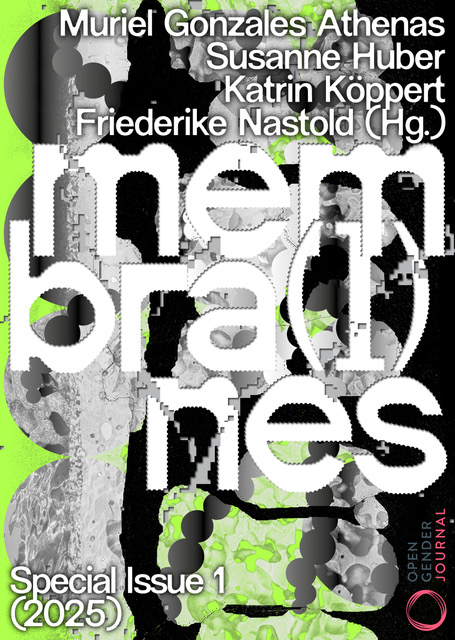White Roses, Pink Glitter. Learning about Embodied Knowledge from Queer Performance Artists
DOI:
https://doi.org/10.17169/ogj.2025.308Keywords:
Art, Body, Knowledge, Performativity, Queer TheoryAbstract
Queerness is a body practice. Through the practice of Yoggaton, the dancer Maque Pereyra reflects on embodied knowledge that is interconnected with other forms of knowledge. Rena Onat uses this as a vantage point to reflect on how embodied knowledge is accessed and produced through queer performance practice. Referring to Sara Ahmed, she believes that traces of colonial and other traumas are physically imprinted into and onto our bodies. She argues that accessing embodied knowledge is difficult as it can be overwhelming or too painful. The main focus of this article is an analysis of Leman Sevda Darıcıoğlu’s performance “White Roses, Pink Glitter” exploring their performance work as an artistic approach to researching trauma, queer death and queer connection. The work addresses mourning for Zak Kostopoulus (aka Zackie Oh), a drag queen and HIV activist from Athens who fell victim to an anti-queer hatecrime, as well as the German resistance group White Rose. Thereby, Darıcıoğlu connects themselves with (queer) histories of resistance and queer affect. Thus, there performance practice is considered a medium for the study of embodied knowledge with a queer approach.
References
Afonu, Dzifa/Haritaworn, Jin/Rage, Raju (2018): Von Archiven und alternativen Zukünften. In: Bauche, Manuela/Otoo, Sharon Dodua (Ed.): Geschichte schreiben. Frankfurt am Main: S. Fischer, 133–139.
Ahmed, Sara (2006): Queer Phenomenology. Orientations, Objects, Others. Durham, London: Duke University Press.
Ahmed, Sara (2004): The Cultural Politics of Emotion. Edinburgh: Edinburgh University Press.
Anzaldúa, Gloria (1987): Borderlands/La Frontera. The New Mestiza. San Francisco: Spinsters/Aunt Lute.
Bayramoğlu, Yener (2022): Shady Ancestors. Queering Digital Diaspora Research. Global Media Journal ‒ German Edition 11(2). doi: 10.22032/dbt.51026
Butler, Judith (1993): Bodies That Matter. On the Discursive Limits of ‘Sex’. London: Routledge.
Cvetkovich, Ann (2015): An Archive of Feelings. Trauma, Sexuality, and Lesbian Public Cultures. Durham, London: Duke University Press.
Darıcıoğlu, Leman Sevda (2024a): Home. https://lemandaricioglu.com (15.08.2024).
Darıcıoğlu, Leman Sevda (2024b): Written feedback to Rena Onat, 11 August 2024.
Darıcıoğlu, Leman Sevda (2023): In personal conversation with Rena Onat, 11 April 2023 in Berlin-Neukölln.
Darıcıoğlu, Leman Sevda (2020): White Roses, Pink Glitter. https://lemandaricioglu.com/white-roses-pink-glitter/ (15.08.2024).
Foucault, Michel (2003 (1976)): Sexualität und Wahrheit. Frankfurt am Main: Suhrkamp.
Gehm, Sabine/Husemann, Pirkko/von Wilcke, Katharina (Ed.) (2007): Wissen in Bewegung. Perspektiven der künstlerischen und wissenschaftlichen Forschung im Tanz. Bielefeld: transcript. doi: 10.14361/9783839408087-014
Grosz, Elizabeth (1994): Volatile Bodies. Toward a Corporeal Feminism. London: Routledge. doi: 10.1215/9780822383574
Haritaworn, Jin (2015): Queer Lovers and Hateful Others. Regenerating Violent Times and Places. London: Pluto Press.
Haritaworn, Jin/Snorton, C. R. (2012): Trans Necropolitics. A Transnational Reflection on Violence, Death and the Trans of Color Afterlife. In: Haritaworn, Jin/Adi Kuntsman, Adi/Posocco, Silvia (Ed.): Queer Necropolitics. London: Routledge, 66–76.
Hucal, Sarah (2022): ‘ORFEAS2021’ – Griechenlands erste queere Filmoper, Deutsche Welle. https://www.dw.com/de/orfeas2021-hommage-an-den-lgbtq-aktivisten-zackie-oh/a-60581103 (07.06.2023).
Ifekoya, Evan/Kabir, Raisa/Rage, Raju/Loewe, Rudy (2016): Surviving Art School. An Artist of Colour Tool Kit. Nottingham: Nottingham Contemporary.
Katan, Einav (2016): Embodied Philosophy in Dance. Gaga and Ohad Naharin’s Movement Research. London: Palgrave Macmillan. doi: 10.1057/978-1-137-60186-5
van der Kolk, Bessel (2015): The Body Keeps the Score. New York: Penguin.
Madi Ancestors (2020): Madi Ancestors. Berlin Remembers Turkey’s Queer Idols. http://madiancestors.com/ (15.08.2024).
Massumi, Brian (2022 (2002)): Parables for the Virtual. Movement, Affect, Sensation. Durham: Duke University Press. doi: 10.1215/9780822383574
Merleau-Ponty, Maurice (2002 (1945)): Phenomenology of Perception. London, New York: Routledge; Kegan Paul.
Micossé-Aikins, Sandrine/Rage, Raju/Onat, Rena (2017): Queering and Decolonizing Art and Visual Culture. A Roundtable Discussion. In: Paul, Barbara/Hoenes, Josch/Beyer, Atlanta Ina/Frankenberg, Natascha/Onat, Rena (Ed.): Perverse Assemblages. Queering Heteronormativity Inter/medially. Berlin: Revolver, 61–76.
Mohanty, Chandra Talpade (1988): Under Western Eyes. Feminist Scholarship and Colonial Discourse. Feminist Review (30)1, 61–88. doi: 10.1057/fr.1988.42
Muñoz, José Esteban (2009): Cruising Utopia. The Then and There of Queer Futurity. New York: New York University Press.
Muñoz, José Esteban (1999): Disidentifications. Queers of Color and the Performance of Politics. Minneapolis: University of Minnesota Press.
Nixon, Christopher A. (2023): ‘Working to Transform the Image’. Postkoloniale Bildkritik, Bildpolitik und die zeitgenössische Queer-of-Color-Fotografie. Zeitschrift für Medienwissenschaft, Test 29(2), 124–136. doi: 10.25969/mediarep/20052
Onat, Rena (2023): Queere Künstler_innen of Color. Verhandlungen von Disidentifikation, Überleben, und Un-Archiving im deutschen Kontext. Bielefeld: transcript.
Onat, Rena/Pereyra, Maque/Müller, Anisha Gupta (2022): Femmes Talk Embodiment. In: Beitin, Andreas/Koch, Katharina/Ruhkamp, Uta (Ed.): Empowerment. Art and Feminisms. Wolfsburg: Kunstmuseum Wolfsburg.
Özgenç, Oğulcan (2024): Hate attack in İzmir. ‘The attacker was caught thanks to trans women who heard E.Ş.’s cry for help’. https://kaosgl.org/en/single-news/hate-attack-in-izmir-the-attacker-was-caught-thanks-to-trans-women-who-heard-e-s-s-cry-for-help (30.07.2024).
Pembe Hayat (2024): Pembe Hayat. https://www.pembehayat.org/en/ (30.7.2024).
Pereyra, Maque (2024): Yoggaton Mappa. https://yoggaton.com/ (18.07.2024).
Pereyra, Maque (2021): Email-exchange with Rena Onat, 17 March 2021.
Pereyra, Maque (2020): Yoggaton-workshop at Bulbul in Berlin, 15 July 2020.
Performistanbul (2024): Performistanbul. https://www.performistanbul.org (07.08.2024).
Rodríguez Castro, Laura (2020): Decolonial Feminisms, Power and Place. Sentipensando with Rural Women in Colombia. Cham: Palmgrave McMillan. doi: 10.1007/978-3-030-59440-4
Sedgwick, Eve K. (1997): Paranoid Reading and Reparative Reading. Or, Youʼre so Paranoid, You Probably Think This Essay Is About You. In: Sedgwick, Eve Kosofsky (Ed.): Novel Gazing. Queer Readings in Fiction. Durham, NC: Duke University Press, 1–38. doi: 10.1215/9780822382478-001
Werner, Anna-Lena (2020): Let Them Haunt Us. How Contemporary Aesthetics Challenge Trauma as the Unrepresentable. Bielefeld: transcript.

Downloads
Published
How to Cite
Issue
Section
License
Copyright (c) 2025 Rena Onat

This work is licensed under a Creative Commons Attribution 4.0 International License.
All contributions in Open Gender Journal are published under the Creative Commons Attribution 4.0 International license. You may freely make use of the corresponding texts in accordance to the conditions of the license (License contract, generally understandable version). There is no exclusive transfer of usage rights ("copyright transfer"). Open Gender Journal does not charge authors any costs for publication (so-called Article Processing Charges, APC) or submission (so-called Submission Charges). Authors are encouraged to share their contributions in other places, such as repositories.












